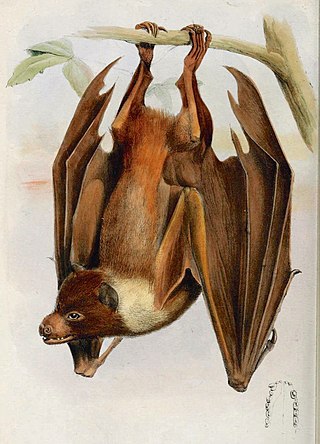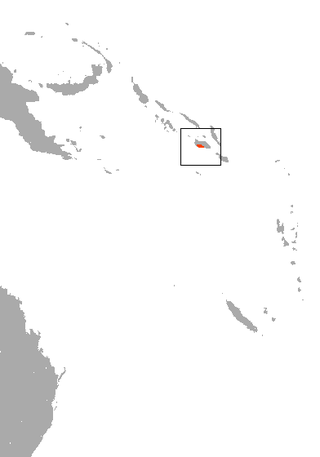
The Vanuatu rain forests are tropical and subtropical moist broadleaf forests ecoregion which includes the islands of Vanuatu, as well as the Santa Cruz Islands group of the neighboring Solomon Islands. It is part of the Australasian realm, which includes neighboring New Caledonia and the Solomon Islands, as well as Australia, New Guinea, and New Zealand.

The Mariana fruit bat, also known as the Mariana flying fox, and the fanihi in Chamorro, is a megabat found only in the Mariana Islands and Ulithi. Habitat loss has driven it to endangered status, and it is listed as threatened by the US Fish and Wildlife Service. Poachers and food hunters, other animals, and natural causes have led to the decline.

Pteropus is a genus of megabats which are among the largest bats in the world. They are commonly known as fruit bats or flying foxes, among other colloquial names. They live in South Asia, Southeast Asia, Australia, East Africa, and some oceanic islands in the Indian and Pacific Oceans. There are at least 60 extant species in the genus.

Livingstone's fruit bat, also called the Comoro flying fox, is a megabat in the genus Pteropus. It is an Old World fruit bat found only in the Anjouan and Mohéli islands in the Union of the Comoros in the western Indian Ocean.

The Admiralty flying fox is a species of fruit bat in the family Pteropodidae, the megabats. It is found in Papua New Guinea and the Solomon Islands.

The Aldabra flying fox is a species of megabat in the genus Pteropus. It is endemic to the Aldabra Atoll in the Seychelles, like Chaerephon pusilla, though the latter may be the same species as the little free-tailed bat.

The Banks flying fox is a species of megabat in the family Pteropodidae. It is endemic to Vanuatu. Its natural habitats are subtropical or tropical dry forests and subtropical or tropical swamps. These small fruit bats are about 15 cm. long with grey and brown on its head and back with a yellow-orange neck and yellow-gray bellies. Its diet consists of coconut flowers and Vaveli trees fruit since its home is tropical.

The small flying fox, island flying fox or variable flying fox is a species of flying fox in the family Pteropodidae. It is found in Australia, Cambodia, Indonesia, Malaysia, the Maldives, Myanmar, Papua New Guinea, the Philippines, the Solomon Islands, Thailand, and Vietnam.

The Temotu flying fox is a species of flying fox in the family Pteropodidae. It is endemic to the Solomon Islands. It is threatened by habitat destruction due to subsistence agricultural practices, as well as natural disasters such as tropical cyclones. Due to its imperiled status, it is identified by the Alliance for Zero Extinction as a species in danger of imminent extinction. In 2013, Bat Conservation International listed this species as one of the 35 species of its worldwide priority list of conservation.

Pteropus pelagicus is a species of fruit bat in the family Pteropodidae. It includes two subspecies that were formerly recognized as full species— Pteropus insularis and Pteropus phaeocephalus. It is endemic to Micronesia. It is threatened by habitat loss.

The Rodrigues flying fox or Rodrigues fruit bat is a species of bat in the family Pteropodidae, the flying foxes or fruit bats. It is endemic to Rodrigues, an island in the Indian Ocean belonging to Mauritius. Its natural habitat is tropical lowland forests. The bats are sociable, roost in large groups during the day and feed at night, squeezing the juice and flesh out of fruits. They are hunted by humans for food and their numbers have been dwindling, and the International Union for Conservation of Nature has rated the species as being "endangered". In an effort to preserve them from extinction, some bats have been caught and are being bred in various zoos around the world.

The insular flying fox or Pacific flying fox is a species of flying fox in the family Pteropodidae. It is geographically widespread, the most widespread flying fox in the Pacific: it is found in American Samoa, the Cook Islands, Fiji, New Caledonia, Niue, Papua New Guinea, Samoa, the Solomon Islands, Tonga, and Vanuatu.

The Fijian monkey-faced bat Also known as Fijian flying fox or Fijian flying monkey, is a megabat endemic to Fiji. It was discovered in old-growth cloud forest on Des Vœux Peak, the second highest mountain peak on the island of Taveuni by William and Ruth Beckon in 1976, and is Fiji's only endemic mammal. It has recently been transferred from Pteralopex to its own monotypic genus Mirimiri.

The Bougainville monkey-faced bat or Bougainville flying monkey is a megabat endemic to Bougainville Island of Papua New Guinea and Choiseul Island of the Solomon Islands in Melanesia. It inhabits mature forests in upland areas, within the Autonomous Region of Bougainville and Bougouriba Province.

The montane monkey-faced bat or montane flying monkey is a megabat endemic to the Solomon Islands. It is listed as a critically endangered species. Due to its imperilled status, it is identified by the Alliance for Zero Extinction as a species in danger of imminent extinction. In 2013, Bat Conservation International listed this species as one of the 35 species of its worldwide priority list of conservation. Only one individual has ever been found.
Bat Conservation International (BCI) is an international nongovernmental organization working to conserve bats and their habitats through conservation, education, and research efforts.

The Makira flying fox is a species of megabat in the genus Pteropus, found in the Solomon Islands. The species is currently decreasing and is endangered due to threats from logging and hunting. In 2013, Bat Conservation International listed this species as one of the 35 species of its worldwide priority list of conservation.

The Rennell flying fox is a species of flying fox found in the Solomon Islands. It is an endangered species risking extinction.

The greater monkey-faced bat or greater flying monkey is a megabat endemic to Solomon Islands, Bougainville, in Papua New Guinea, and nearby small islands. It is listed as a critically endangered species and the population is decreasing. It is the largest monkey-faced bat.




















